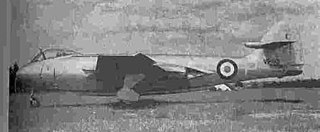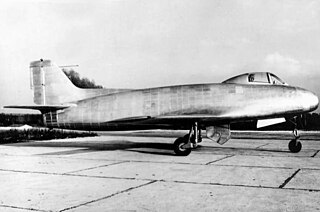
The McDonnell XF-88 Voodoo was a long-range, twinjet fighter aircraft with swept wings designed for the United States Air Force. Although it never entered production, its design was adapted for the subsequent supersonic F-101 Voodoo.

The Republic XF-91 Thunderceptor is a mixed-propulsion prototype interceptor aircraft, developed by Republic Aviation. The aircraft would use a jet engine for most flight, and a cluster of four small rocket engines for added thrust during climb and interception. The design was largely obsolete by the time it was completed due to the rapidly increasing performance of contemporary jet engines, and only two prototypes were built. One of these was the first American fighter to exceed Mach 1 in level flight.

The Mikoyan-Gurevich I-250, aka MiG-13, was a Soviet fighter aircraft developed as part of a crash program in 1944 to develop a high-performance fighter to counter German turbojet-powered aircraft such as the Messerschmitt Me 262. The Mikoyan-Gurevich design bureau decided to focus on a design that used something more mature than the jet engine, which was still at an experimental stage in the Soviet Union, and chose a mixed-power solution with the VRDK motorjet powered by the Klimov VK-107 V12 engine. While quite successful when it worked, with a maximum speed of 820 km/h (510 mph) being reached during trials, production problems with the VRDK fatally delayed the program and it was canceled in 1948 as obsolete.

The McDonnell XF-85 Goblin is an American prototype fighter aircraft conceived during World War II by McDonnell Aircraft. It was intended to deploy from the bomb bay of the Convair B-36 bomber as a parasite fighter. The XF-85's intended role was to defend bombers from hostile interceptor aircraft, a need demonstrated during World War II. McDonnell built two prototypes before the Air Force (USAF) terminated the program.

The Bell P-59 Airacomet is a single-seat, twin jet-engine fighter aircraft that was designed and built by Bell Aircraft during World War II. It was the first jet produced in the United States. As the British were further along in jet engine development, they donated an engine for the United States to copy in 1941 that became the basis for the General Electric J31 jet engine used by the P-59 a year later. Because the plane was underpowered, the United States Army Air Forces (USAAF) was not impressed by its performance and canceled half of the original order for 100 fighters, using the completed aircraft as trainers. The USAAF would instead go on to select the Lockheed P-80 Shooting Star as its first operational jet fighter. Although no P-59s entered combat, the aircraft paved the way for later generations of U.S. turbojet-powered aircraft.

The Republic XF-103 was an American project to develop a powerful missile-armed interceptor aircraft capable of destroying Soviet bombers while flying at speeds as high as Mach 3. Despite a prolonged development, it never progressed past the mockup stage.

The Lockheed XF-90 was built in response to a United States Air Force requirement for a long-range penetration fighter and bomber escort. The same requirement produced the McDonnell XF-88 Voodoo. Lockheed received a contract for two prototype XP-90s. The design was developed by Willis Hawkins and the Skunk Works team under Kelly Johnson. Two prototypes were built. Developmental and political difficulties delayed the first flight until 3 June 1949, with Chief Test Pilot Tony LeVier at the controls. Embodying the experience gained in developing the P-80 Shooting Star, the XF-90 shared some design traits with the older Lockheed fighter, albeit with swept-wings; however, this latter design choice could not sufficiently make up for the project’s underpowered engines, and the XF-90 never entered production.

The Yakovlev Yak-23 is an early Soviet jet fighter with a straight wing. It was developed from the Yak-17 in the late 1940s and used a reverse-engineered copy of a British engine. It was not built in large numbers as it was inferior in performance to the swept-wing Mikoyan-Gurevich MiG-15. Many Yak-23s were exported to the Warsaw Pact nations and remained in service for most of the 1950s, although some were still in use a decade later.

The Yakovlev Yak-19 was a prototype Soviet fighter built in the late 1940s. It was the first Soviet aircraft to be equipped with an afterburning turbojet, the Klimov RD-10F that was derived from the German Jumo 004 engine. Only two examples were built as it was rejected for service by the Soviet Air Force.

The Grumman XP-50 was a land-based development of the shipboard XF5F-1 Skyrocket fighter, entered into a United States Army Air Corps (USAAC) contest for a twin-engine heavy interceptor aircraft. The USAAC placed an order for a prototype on 25 November 1939, designating it XP-50, but it lost the competition to the Lockheed XP-49.

The McDonnell XP-67 "Bat" or "Moonbat" was a prototype for a twin-engine, long-range, single-seat interceptor aircraft for the United States Army Air Forces. Although the design was conceptually advanced, it was beset by numerous problems and never approached its anticipated level of performance. The project was canceled after the sole completed prototype was destroyed by an engine fire.

The Lockheed XP-58 Chain Lightning was an American long-range fighter developed during World War II. Although derived from the successful P-38 Lightning, the XP-58 was plagued by technical problems with its engines that eventually led to the project's cancellation.

The Hawker P.1072 was a 1949 experimental British aircraft acting as a test bed for the Armstrong Siddeley Snarler rocket booster engine. It was the prototype Hawker Sea Hawk modified to install the rocket in the tail.

The Vought F6U Pirate was the Vought company's first jet fighter, designed for the United States Navy during the mid-1940s. Although pioneering the use of turbojet power as the first naval fighter with an afterburner and composite material construction, the aircraft proved to be underpowered and was judged unsuitable for combat. None were ever issued to operational squadrons and they were relegated to development, training, and test roles before they were withdrawn from service in 1950.

The Yakovlev Yak-25 was a Soviet military aircraft, an early turbojet-powered fighter aircraft designed by the Yakovlev OKB. The designation was later reused for a different interceptor design. Tasked by the Council of Ministers in a directive issued on 11 March 1947, with producing a straight winged fighter similar to the earlier Yak-19, but powered by a Rolls-Royce Derwent V, OKB-115 swiftly produced the Yak-25, which blazed several trails as the first Soviet fighter with a fully pressurised cockpit, air conditioning, jettisonable canopy, and hydraulic airbrakes on the fuselage amongst other innovations.

The Messerschmitt P.1101 was a single-seat, single-jet fighter project of World War II, developed as part of the 15 July 1944 Emergency Fighter Program which sought a second generation of jet fighters for the Third Reich. A prominent feature of the P.1101 prototype was that the sweep angle of the wings could be changed before flight, a feature further developed in later variable-sweep aircraft such as the Bell X-5 and Grumman XF10F Jaguar.

The Arsenal VG 90 was a French carrier-based jet-engined interceptor developed in the late 1940s. It was intended to compete for an Aéronavale contract and first flew in 1949. It set a speed record for a French aircraft the following year, but both of the completed prototypes were destroyed in fatal crashes and the program was cancelled in 1952 before the third prototype was finished. The Aéronavale contract was eventually awarded to a license-built British aircraft. The remains of the last VG 90 were scrapped in 1978.

The Leduc 022 was the prototype of a mixed-power French interceptor built in the mid-1950s. Designer René Leduc had been developing ramjet-powered aircraft since before World War II and had flown a series of experimental aircraft, the Leduc 0.10 and Leduc 0.21, throughout the 1950s before he was awarded a contract for two examples of a short-range supersonic interceptor armed with two air-to-air missiles (AAMs).
The Alekseyev I-212 was a twin-engined, jet fighter designed in the USSR in 1947 at OKB-21. It was a two-seat variant of the I-21 designed in response to a requirement for a very long-range fighter issued by the Voenno-Vozdushnye Sily (VVS),, in 1946. Intended as an escort fighter, it was also designed for use as a night fighter and reconnaissance aircraft. No prototype was built, although some parts may have begun building before the project was completed.

The Nord 2200 was a French carrier-based, jet-engined interceptor developed in the late 1940s. It was intended to compete for an Aéronavale contract, but was not selected for production after a 1950 accident badly damaged the sole prototype. It was repaired and resumed flight testing the following year, which including evaluating rocket-assisted take offs. After the aircraft made its last flight in 1954, it was used as a gunnery target. Much of the airframe was recovered in the 1980s, but its current disposition is uncertain.




















